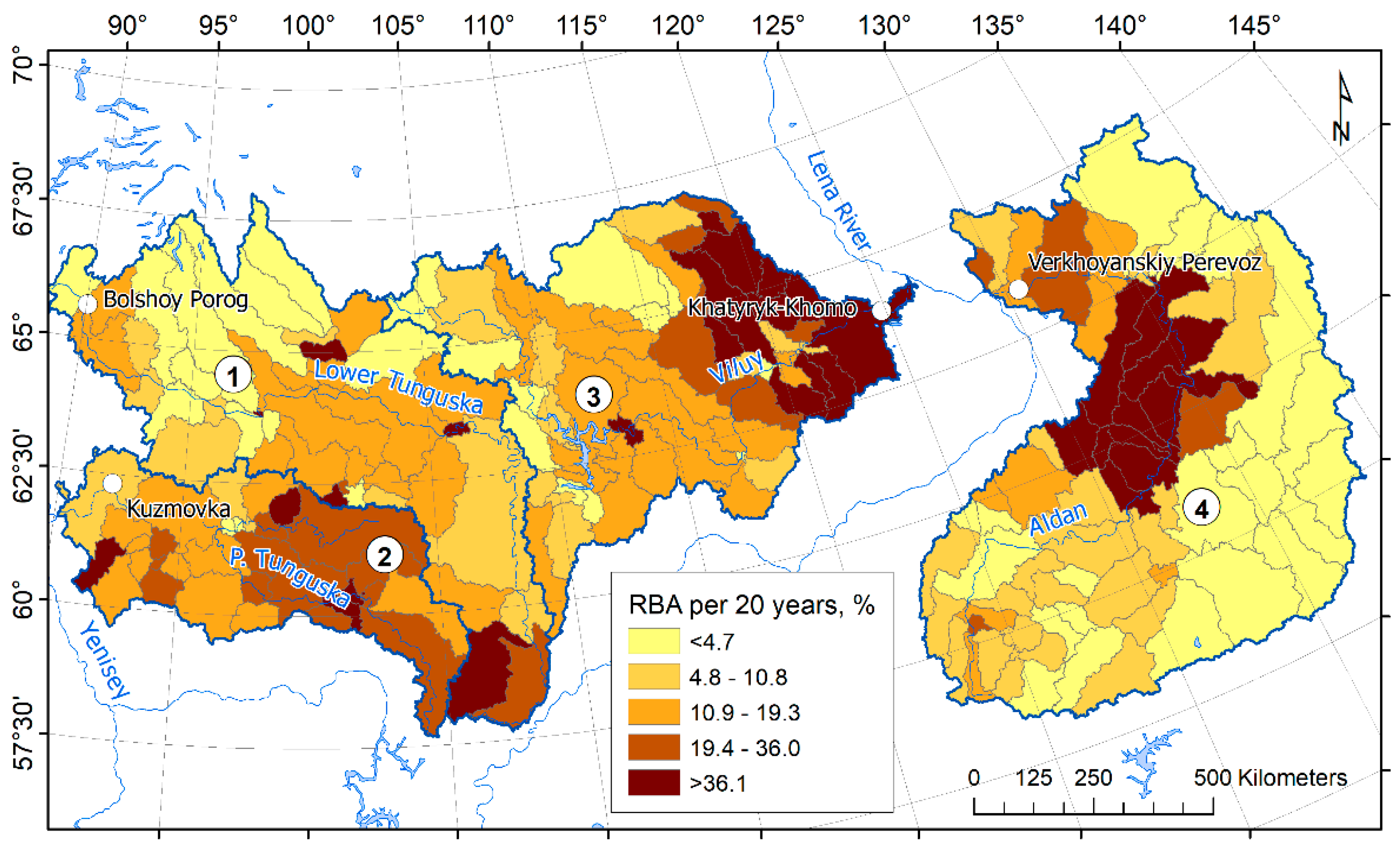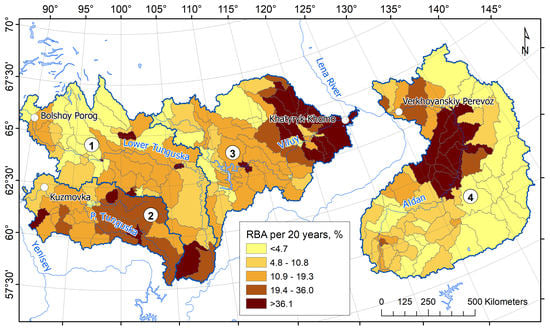Intraseasonal Dynamics of River Discharge and Burned Forest Areas in Siberia
Abstract
:1. Introduction
2. Materials and Methods
3. Results
4. Discussion
5. Conclusions
Author Contributions
Funding
Acknowledgments
Conflicts of Interest
References
- Water of Russia. Electronic Resource. Available online: http://water-rf.ru/ (accessed on 9 April 2019).
- Georgiadi, A.G.; Kashutina, E.A. Long-term runoff changes of the largest Siberian Rivers. Izv. Akad. Sci. Ser. Geogr. 2016, 5, 70–81. (In Russian) [Google Scholar] [CrossRef]
- Onuchin, A.A. The reasons for conceptual contradictions in evaluating hydrological role of boreal forests. Sib. J. For. Sci. 2015, 2, 41–54. (In Russian) [Google Scholar] [CrossRef]
- Shiklomanov, A.I.; Lammers, R.B.; Rawlins, M.A.; Smith, L.C.; Pavelsky, T.M. Temporal and spatial variations in maximum river discharge from a new Russian data set. J. Geophys. Res. 2007, 112, G04S53. [Google Scholar] [CrossRef]
- Ponomarev, E.I.; Skorobogatova, A.S.; Ponomareva, T.V. Wildfire Occurrence in Siberia and Seasonal Variations in Heat and Moisture Supply. Russ. Meteorol. Hydrol. 2018, 43, 456–463. [Google Scholar] [CrossRef]
- Bartsch, A.; Balzter, H.; George, C. Influence of regional surface soil moisture anomalies on forest fires in Siberia observed from satellites. Environ. Res. Lett. 2009, 4, 045021. [Google Scholar] [CrossRef]
- Kharuk, V.I.; Dvinskaya, M.L.; Petrov, I.A.; Im, S.T.; Ranson, K.J. Larch Forests of Middle Siberia: Long-Term Trends in Fire Return Intervals. Reg. Environ. Chang. 2016, 8, 2389–2397. [Google Scholar] [CrossRef]
- Brown, D.R.N.; Jorgenson, M.T.; Kielland, K.; Verbyla, D.L.; Prakash, A.; Koch, J.C. Landscape Effects of Wildfire on Permafrost Distribution in Interior Alaska Derived from Remote Sensing. Remote Sens. 2016, 8, 654. [Google Scholar] [CrossRef]
- Knorre, A.A.; Kirdyanov, A.V.; Prokushkin, A.S.; Krusic, P.J.; Buntgen, U. Tree ring-based reconstruction of the long-terminfluence of wildfires on permafrost active layer dynamics in Central Siberia. Sci. Total Environ. 2019, 652, 314–319. [Google Scholar] [CrossRef]
- Neary, D.G.; Gottfried, G.J.; Ffolliott, P.F. Post-Wildfire Watershed Flood Responses. In Proceedings of the Second International Fire Ecology and Fire Management Congress, Paper 1B7, Orlando, FL, USA, 16–20 November 2003. [Google Scholar]
- Forkel, M.; Thonicke, K.; Beer, C.; Cramer, W.; Bartalev, S.; Schmullius, C. Extreme fire events are related to previous-year surface moisture conditions in permafrost-underlain larch forests of Siberia. Environ. Res. Lett. 2012, 7, 044021. [Google Scholar] [CrossRef]
- Ponomarev, E.I.; Ponomareva, T.V. The Effect of Postfire Temperature Anomalies on Seasonal Soil Thawing in the Permafrost Zone of Central Siberia Evaluated Using Remote Data. Contemp. Probl. Ecol. 2018, 11, 420–427. [Google Scholar] [CrossRef]
- Anisimov, O.A.; Sherstiukov, A.B. Evaluating the effect of environmental factors on permafrost in Russia. Earth’s Cryosph. 2016, XX, 90–99. (In Russian) [Google Scholar]
- Bezkorovaynaya, I.N.; Borisova, I.V.; Klimchenko, A.V.; Shabalina, O.M.; Zakharchenko, L.P.; Il’in, A.A.; Beskrovny, A.K. Influence of the pyrogenic factor on the biological activity of the soil in permafrost conditions (Central Evenkia). Vestn. KrasGAU 2017, 9, 181–189. (In Russian) [Google Scholar]
- Dymov, A.A.; Dubrovsky, Y.A.; Gabov, D.N. Pyrogenic Changes in Iron-Illuvial Podzols in the Middle Taiga of the Komi Republic. Eurasian Soil Sci. 2014, 47, 47–56. [Google Scholar] [CrossRef]
- Brown, D.R.N.; Jorgenson, M.T.; Douglas, T.A.; Romanovsky, V.E.; Kielland, K.; Hiemstra, C.; Euskirchen, E.S.; Ruess, R.W. Interactive effects of wildfire and climate on permafrost degradation in Alaskan lowland forests. J. Geophys. Res. Biogeosci. 2015, 120, 1619–1637. [Google Scholar] [CrossRef]
- Batelis, S.; Nalbantis, I. Potential effects of forest fires on streamflow in the Enipeas River Basin, Thessaly, Greece. Environ. Process. 2014, 1, 73–85. [Google Scholar] [CrossRef]
- Havel, A.; Tasdighi, A.; Arabi, M. Assessing the hydrologic response to wildfires in mountainous regions. Hydrol. Earth Syst. Sci. 2018, 22, 2527–2550. [Google Scholar] [CrossRef] [Green Version]
- Springer, J.; Ludwig, R.; Kienzle, S.W. Impacts of Forest Fires and Climate Variability on the Hydrology of an Alpine Medium Sized Catchment in the Canadian Rocky Mountains. Hydrology 2015, 2, 23–47. [Google Scholar] [CrossRef] [Green Version]
- McClelland, J.W.; Holmes, R.M.; Peterson, B.J.; Stieglitz, M. Increasing river discharge in the Eurasian Arctic: Consideration of dams, permafrost thaw, and fires as potential agents of change. J. Geophys. Res. 2004, 109, D18102. [Google Scholar] [CrossRef]
- Zipper, S.C.; Lamontagne-Hallé, P.; McKenzie, J.M.; Rocha, A.V. Groundwater controls on postfire permafrost thaw: Water and energy balance effects. J. Geophys. Res. Earth Surf. 2018, 123, 2677–2694. [Google Scholar] [CrossRef]
- Prokushkin, A.S.; Hobara, S.; Prokushkin, S.G. Behavior of Dissolved Organic Carbon in Larch Ecosystem. In Permafrost Ecosystems, Siberian Larch Forests; Osawa, A., Zyryanova, O.A., Matsuura, Y., Kajimoto, T., Wein, R.W., Eds.; Springer: London, UK, 2010; pp. 205–225. [Google Scholar]
- Ponomarev, E.I.; Kharuk, V.I.; Ranson, J.K. Wildfires Dynamics in Siberian Larch Forests. Forests 2016, 7, 125. [Google Scholar] [CrossRef]
- Fedorov, A.N.; Vasilyev, N.F.; Torgovkin, Y.I.; Shestakova, A.A.; Varlamov, S.P.; Zheleznyak, M.N.; Shepelev, V.V.; Konstantinov, P.Y.; Kalinicheva, S.S.; Basharin, N.I.; et al. Permafrost-Landscape Map of the Republic of Sakha (Yakutia) on a Scale 1:1,500,000. Geosciences 2018, 8, 465. [Google Scholar] [CrossRef]
- Bring, A.; Shiklomanov, A.; Lammers, R.B. Pan-Arctic river discharge: Prioritizing monitoring of future climate change hot spots. Earth’s Future 2017, 5, 72–92. [Google Scholar] [CrossRef]
- Holmes, R.M.; Shiklomanov, A.I.; Tank, S.E.; McClelland, J.W.; Tretiakov, M. River Discharge; Arctic Report Card: Update for 2015. Available online: https://www.arctic.noaa.gov/Report-Card/Report-Card-2015/ArtMID/5037/ArticleID/227/River-Discharge (accessed on 18 October 2018).
- Lehner, B.; Grill, G. Global river hydrography and network routing: Baseline data and new approaches to study the world’s large river systems. Hydrol. Process. 2013, 27, 2171–2186. [Google Scholar] [CrossRef]
- Valendik, E.N.; Ivanova, G.A. Extreme fire seasons in the boreal forests of Central Siberia. For. Sci. 1996, 4, 12–19. (In Russian) [Google Scholar]
- Ivanova, G.A. The history of forest fire in Russia. Dendrochronology 1999, 16–17, 147–161. [Google Scholar]
- Ponomarev, E.I.; Shvetsov, E.G. Satellite detection of forest fires and GIS-methods for result calibration. Issled. Zemli iz Kosmosa (Rem. Sens.) 2015, 1, 84–91. (In Russian) [Google Scholar] [CrossRef]
- Kharuk, V.I.; Ponomarev, E.I. Spatiotemporal characteristics of wildfire frequency and relative area burned in larch-dominated forests of Central Siberia. Russ. J. Ecol. 2017, 48, 507–512. [Google Scholar] [CrossRef]
- Schneider, U.; Becker, A.; Finger, P.; Meyer-Christoffer, A.; Rudolf, B.; Ziese, M. GPCC Full Data Monthly Product Version 7.0 at 1.0: Monthly Land-Surface Precipitation from Rain-Gauges built on GTS-based and Historic Data. 2015. [Google Scholar] [CrossRef]
- Hawkins, D. Biomeasurement. A Student’s Guide Biological Statistics, 3rd ed.; Oxford University Press: New York, NY, USA, 2014; 333p. [Google Scholar]
- De Groot, W.J.; Cantin, A.S.; Flannigan, M.D.; Soja, A.J.; Gowman, L.M.; Newbery, A. A comparison of Canadian and Russian boreal forest fire regimes. For. Ecol. Manag. 2013, 294, 23–34. [Google Scholar] [CrossRef]
- Woods, S.W.; Birkas, A.; Ahl, R. Spatial variability of soil hydrophobicity after wildfires in Montana and Colorado. Geomorphology 2007, 86, 465–479. [Google Scholar] [CrossRef]
- Robichaud, P.R.; Miller, S.M. Spatial interpolation and simulation of post-burn duff thickness after prescribed fire. Int. J. Wildland Fire 1999, 9, 137–143. [Google Scholar] [CrossRef] [Green Version]
- Im, S.T.; Kharuk, V.I. Water mass dynamics in permafrost of Central Siberia based on GRACE gravity data. Izv. Atmos. Ocean. Phys. 2015, 51, 806–818. [Google Scholar] [CrossRef]
- Flannigan, M.; Stocks, B.; Turetsky, M.; Wotton, M. Impacts of climate change on fire activity and fire management in the circumboreal forest. Glob. Chang. Biol. 2009, 15, 549–560. [Google Scholar] [CrossRef]





| River Name | Area of Basin, mln ha | Discharge, km3 | Discharge Anomaly, % | γ, % | |||
|---|---|---|---|---|---|---|---|
| Min. | Max. | Mean | σ | Max. | |||
| Lower Tunguska | 45.6 | 108.25 | −22 | 29 | 0.49 | 0.60 | 2.99 |
| Podkamennaya Tunguska | 23.8 | 49.87 | −21 | 40 | 0.51 | 0.65 | 4.12 |
| Viluy | 45.5 | 47.97 | −32 | 36 | 0.76 | 1.15 | 6.13 |
| Aldan | 72.8 | 173.59 | −28 | 32 | 0.67 | 0.77 | 5.21 |
| River Name | Correlation Level | |||
|---|---|---|---|---|
| November–February | March–April | May–July | August–October | |
| Lower Tunguska | −0.43 | −0.25 | −0.83 | −0.77 |
| Podkamennaya Tunguska | −0.20 | −0.24 | −0.66 | −0.57 |
| Viluy | −0.22 | −0.16 | −0.42 | −0.42 |
| Aldan | −0.21 | −0.10 | −0.47 | −0.22 |
| River Discharge Anomalies Per Month | |||||||
|---|---|---|---|---|---|---|---|
| April | May | June | July | August | September | ||
| Relative Burned Area per Month, % | Lower Tunguska | ||||||
| April | NA | NA | |||||
| May | NA | NA | −0.60 | ||||
| June | −0.11 | −0.64 | −0.52 * | ||||
| July | −0.29 | −0.59 | −0.65 * | ||||
| August | −0.81 | −0.88 | −0.68 * | ||||
| Podkamennaya Tunguska | |||||||
| April | NA | NA | |||||
| May | 0.07 | −0.33 | −0.54 * | ||||
| June | −0.23 | −0.45 | −0.49 | ||||
| July | −0.34 | −0.73 | −0.68 * | ||||
| August | −0.40 | −0.63 | −0.38 | ||||
| Aldan | |||||||
| April | −0.32 | −0.41 | |||||
| May | −0.38 | −0.38 | −0.45 * | ||||
| June | 0.13 | −0.44 | −0.11 | ||||
| July | −0.57 | −0.21 | −0.19 | ||||
| August | −0.30 | −0.52 | −0.22 | ||||
| Viluy | |||||||
| April | −0.33 | −0.54 * | |||||
| May | 0.03 | −0.43 | −0.53 * | ||||
| June | −0.40 | −0.50 | −0.42 | ||||
| July | −0.28 | −0.45 | −0.32 | ||||
| August | −0.50 | −0.59 | −0.45 * | ||||
© 2019 by the authors. Licensee MDPI, Basel, Switzerland. This article is an open access article distributed under the terms and conditions of the Creative Commons Attribution (CC BY) license (http://creativecommons.org/licenses/by/4.0/).
Share and Cite
Ponomarev, E.I.; Ponomareva, T.V.; Prokushkin, A.S. Intraseasonal Dynamics of River Discharge and Burned Forest Areas in Siberia. Water 2019, 11, 1146. https://doi.org/10.3390/w11061146
Ponomarev EI, Ponomareva TV, Prokushkin AS. Intraseasonal Dynamics of River Discharge and Burned Forest Areas in Siberia. Water. 2019; 11(6):1146. https://doi.org/10.3390/w11061146
Chicago/Turabian StylePonomarev, Evgenii I., Tatiana V. Ponomareva, and Anatoly S. Prokushkin. 2019. "Intraseasonal Dynamics of River Discharge and Burned Forest Areas in Siberia" Water 11, no. 6: 1146. https://doi.org/10.3390/w11061146








